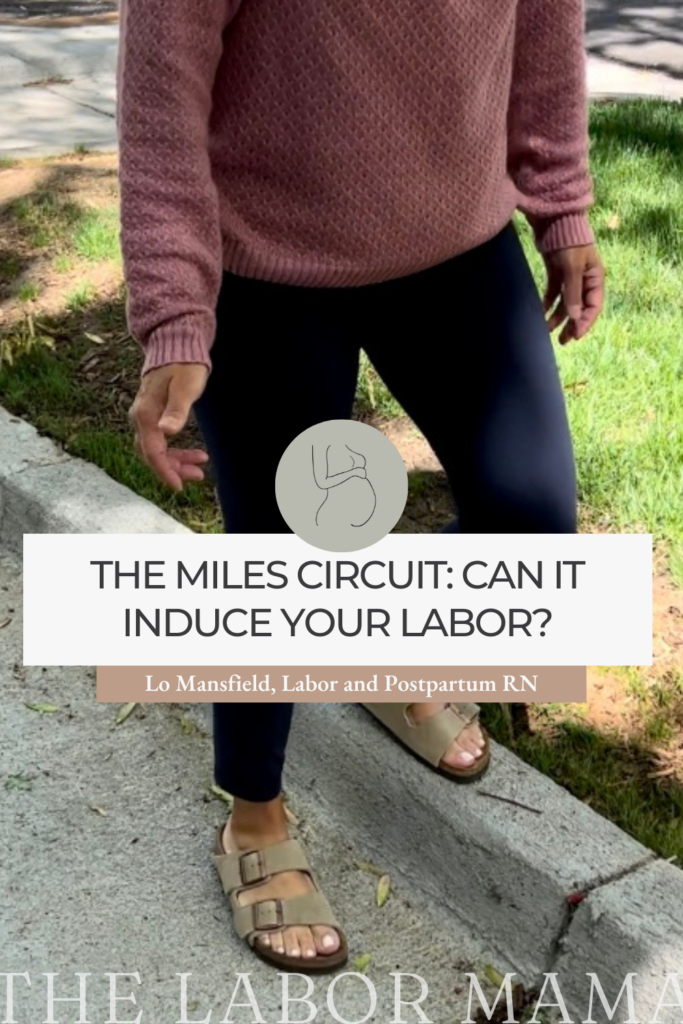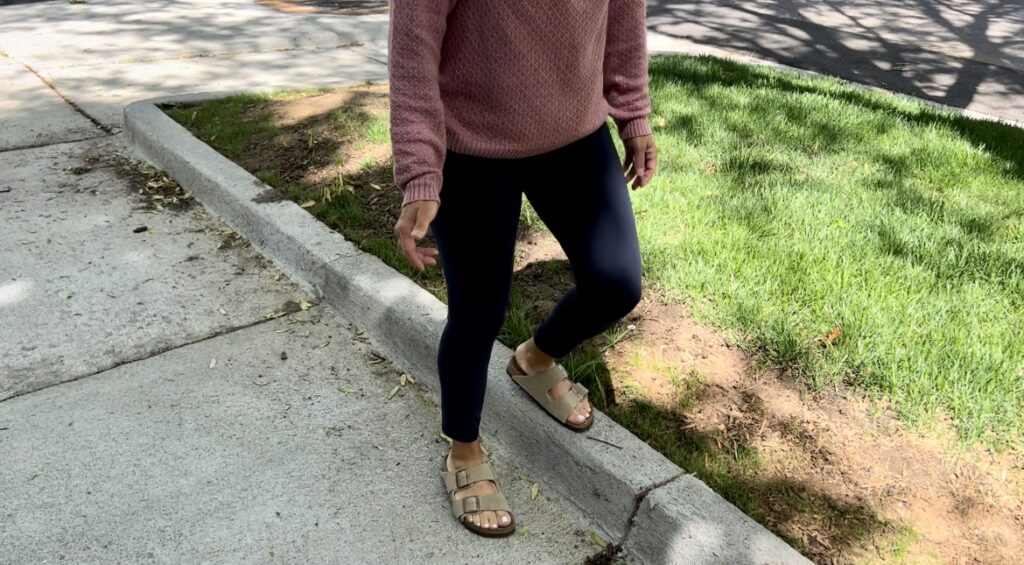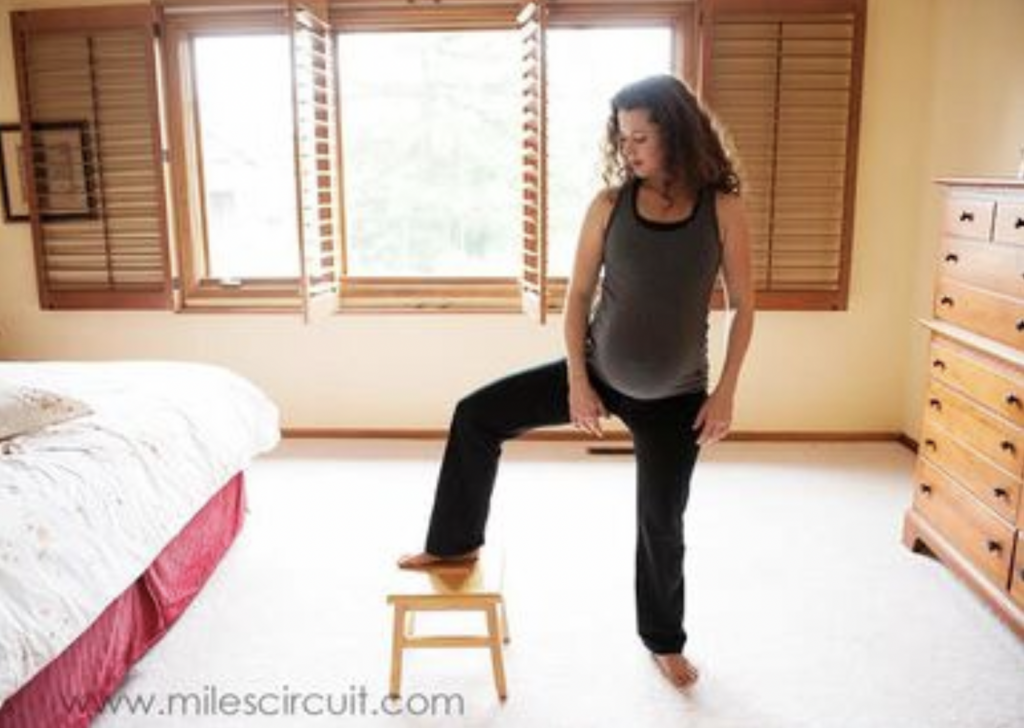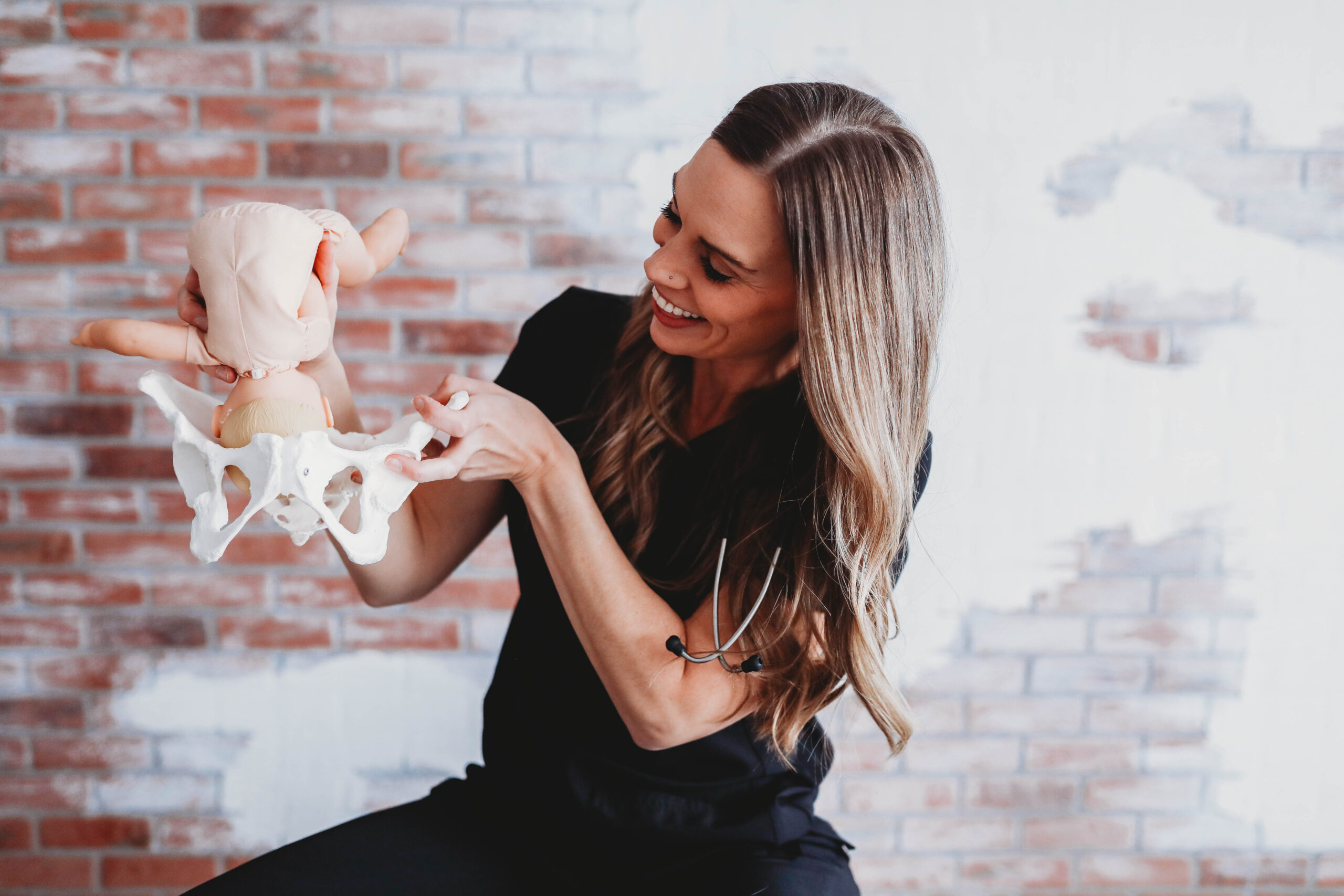Are you getting to that point in your pregnancy where you’re wondering about all the things that you can try at home to induce labor? I’ve been there, mama – so if you are, I get it!
In all 4 of my pregnancies, I’ve been really focused on optimal positioning of baby before labor begins. I actually love the topic so much that I have a lesson about it in Your Body, Your Birth (my online birth course) and I talk about it nonstop on my Instagram. And one of my favorite things to do, especially in relationship to baby’s best position, is the Miles Circuit. If you haven’t heard of it yet, I’m so glad you’re here – keep reading!

Who is The Labor Mama and Why Am I Here?
Hey friend! I’m Lo – also known around here and social media as The Labor Mama. I’ve spent my nursing career in labor, delivery, and postpartum, have birthed 4 of my own babies, have labored thousands of mamas at the bedside, have taught thousands of students online, and have even delivered a few speedy little babies with my bare hands (oops).
Here at TLM, I offer online classes about birth, postpartum, newborn care, and breastfeeding to empower you the way everyone should be. The education + support I offer gives you experience, evidence, and empathy; you’re getting all of my years of “clinical” RN knowledge, honestly combined with my real experiences as a mama, nurse, and CLC. These are not your average hospital classes (those won’t do it, I promise), and honestly, birth, postpartum, and breastfeeding don’t follow a textbook or protocol anyway. You need to know so much more than that!
If you want to connect with me further, head to Instagram. There are hundreds of thousands of us over there learning together daily.
A note: This post may include affiliate links. This means if you make a purchase after clicking a link, I will earn a small commission (thank you)! Rest assured, this comes at no additional cost to you. You can read TLM’s full disclosure here.
What is The Miles Circuit?
The Miles Circuit is a series of intentional movement and positioning that is meant to help induce labor and/or increase the strength of labor. The circuit was developed by doulas Megan Miles and Sharon Duza, as a natural alternative to more medical interventions for induction of labor. By using gravity and a specific pattern of movements, the circuit helps baby engage in the birth canal and smoothly move through the pelvis.
You can learn more about Megan, Sharon, and the circuit here.
Let’s break that clinical language down into simpler terms.
The Miles Circuit can:
- stretch the muscles and ligaments around the pelvis/your lower body;
- help baby engage (this means they scoot down into the pelvis);
- encourage baby to be left occiput anterior (LOA; this means the back of their head is along the front of the maternal body, oriented a bit to the maternal left);
- speed up a stalled labor or a labor that has slowed;
- get you out of prodromal labor and into real labor;
- give you the chance to rest (see step 2 of the circuit below);
- give you some control at home when you’re otherwise going nuts waiting!
What is optimal baby positioning for birth?
I just mentioned the acronym LOA, so let me clarify that a little more. The position of the baby in your body can play a crucial role in the labor process. When baby is “optimal,” it can lead to spontaneous labor, shorten your length of labor, and decrease the need for interventions. Let me quickly go through the letters in the position acronyms one by one.
- O is for occiput. The occiput is the back of the baby’s head.
- A is for anterior. Anterior refers to the front of the maternal body.
- P is for posterior. Posterior refers to the back of the maternal body.
- L is for left. Left refers to to the left side of the maternal body.
- R is for right. Right refers to the right side of the maternal body.
- T is for transverse. This refers to the side of the maternal body.
*Sometimes you will hear the vocabulary “direct OA” or “direct OP.” This means the baby is not oriented to the right or left, but instead is right on the midline of the maternal body.
The most favorable position for delivery is known as the occiput anterior (OA) position, particularly LOA. In this position, the baby’s head is down (vertex), baby is facing the maternal back, and the back of the baby’s head is toward the front of the maternal pelvis with a slight orientation towards the left maternal thigh. This positioning allows for optimal engagement of the baby’s head in the birth canal, making it easier for the baby to navigate (the 7 cardinal movements they make) through the pelvis during labor.

Another position you will probably hear about pretty often is the occiput posterior (OP) position. In this position, baby’s head is down but facing the maternal abdomen instead of the back. This position can lead to a longer and more challenging labor, as well as back labor. This is because the baby’s head is pushing on the lower back and the sacrum, and it may not fit as easily into the pelvis.

Overall, the goal of the Miles Circuit is to get baby oriented OA, and then ideally, LOA. Because babies can continue to rotate throughout labor, the circuit can be helpful both before labor begins and during labor. My birth course goes through all of this in detail, as well as offers many ways to prep before labor and move during labor to avoid that OP positioning!
Does the Miles Circuit really work?
The truth? There is not research to say that the Miles Circuit can actually make labor start. But you will hear a lot of mamas tell you that they did it and that it was a game-changer.
One thing important to note is that most who try the circuit are also doing other “natural induction” things. This may include activities like eating dates, drinking red raspberry leaf tea, or using primrose oil pills. In this circumstance, it’s kind of impossible to say what, if anything, was “the thing” that made it all happen. But I do think circuit has a ton of value that is really important for labor and birth, so let’s walk through that value before we get to what the circuit actually entails.
- Control: The Miles Circuit gives you the chance to do something, in a way that is both natural and non-invasive. Though rest is incredibly valuable in the final weeks of pregnancy, many mamas really appreciate feeling productive or helpful while they wait for baby.
- Fetal Positioning: Like I’ve said a couple times, the circuit is meant to get your baby into the best position for birth. Without question, this positioning has so much value. When baby is in the “right” spot, they have more room to scoot down and put pressure (with their head) onto the cervix. That cause some effacement or dilation, release prostaglandins, and maybe – here comes labor.
- Rest: The Miles Circuit actually offers good deep rest too. Even though some parts of it are active, you are also given the chance to slow down and calm. Your peace and your calm can actually be the trigger for spontaneous labor to begin!
The Three Positions of the Miles Circuit
1. Open-Knee Chest Position: The first position involves getting on your hands and knees and then lowering your head and chest toward the ground while keeping your buttocks elevated. You can do this on the floor (use carpet or a yoga mat!) or you can even do it on your bed! This posture helps create more space in the pelvis. If possible, hold this for 30 minutes.
If you suffer from reflux, this can feel tough. An alternative is the forward leaning inversion!

2. Exaggerated Left Side-Lying: Time to rest! The second position involves laying on your left side and bringing the right leg up as high as possible while the bottom leg stays straight. Use pillows to prop up and support your leg and belly, and roll over onto your left as much as is comfortable. This position helps baby turn to the LOA position, the most optimal one for birth.
If you do the circuit twice in one day, try flip flopping to the other side.

3. Upright Asymmetrical Movement: Most will choose side lunges, curb walking or sideways stair walking. Note that you are going up the stairs sideways and lunging sideways to open the diameter of the mid pelvis. These activities cause asymmetrical movement in the pelvis, giving baby space to move down. You’ll want to do your activity for 30 minutes as well (but you’ll get your daily exercise in too)!



When can you try the circuit?
It’s recommended that you don’t try the Miles Circuit until you are at least 37 weeks pregnant. It’s also a great thing to do in early labor. Don’t let those early contractions stop you! All of these movements are going to encourage labor along and get (or keep) baby right where you want them!
How often should you do the circuit?
If you are past 37 weeks and have the all clear from your provider, you could start to incorporate the circuit into your daily routine. Personally, that feels like a lot to me and I often recommend really thinking about the circuit after your due date passes.
How long does the Miles Circuit take?
If you do the full circuit, you may have noticed that it is 90 minutes long! However, if that feels daunting or not doable, you can start at once a day, 10 minutes in each position. If you want, you can also try engaging in each position for about 10-15 minutes, two to three times a day as a starting point.
As with all things, it’s really important to listen to your body and adjust the duration and frequency based on your comfort level and energy levels. Some may find it beneficial to increase the frequency or duration of the circuit as labor approaches, while others prefer to stick to a consistent routine throughout the last weeks.
More reading for natural induction techniques:
Midwives Brew: Should You Try This Natural Induction Technique
What is a Membrane and Should You Try One?
The takeaway on the Miles Circuit for induction
The Miles Circuit has a lot of value, both mentally and physically! If you are past 37 weeks and are really wanting to do something, this might be it for you. It may also prove valuable if you are experiencing a lot of false labor or prodromal labor. Giving baby the space to wiggle around and get deep in that pelvis may be exactly what you need to naturally induce labor and get things going!
Overall, don’t forget that babies come when they’re ready – and there really is nothing wrong if you’re still pregnant past your due date! Don’t wear yourself out trying all the things – your body and baby know what they’re doing and you can trust that too!
Did you try the Miles Circuit? At what point? Do you think it did anything? Let me know in the comments! xx- Lo

More resources (and freebies!) for you to take a peek at:



